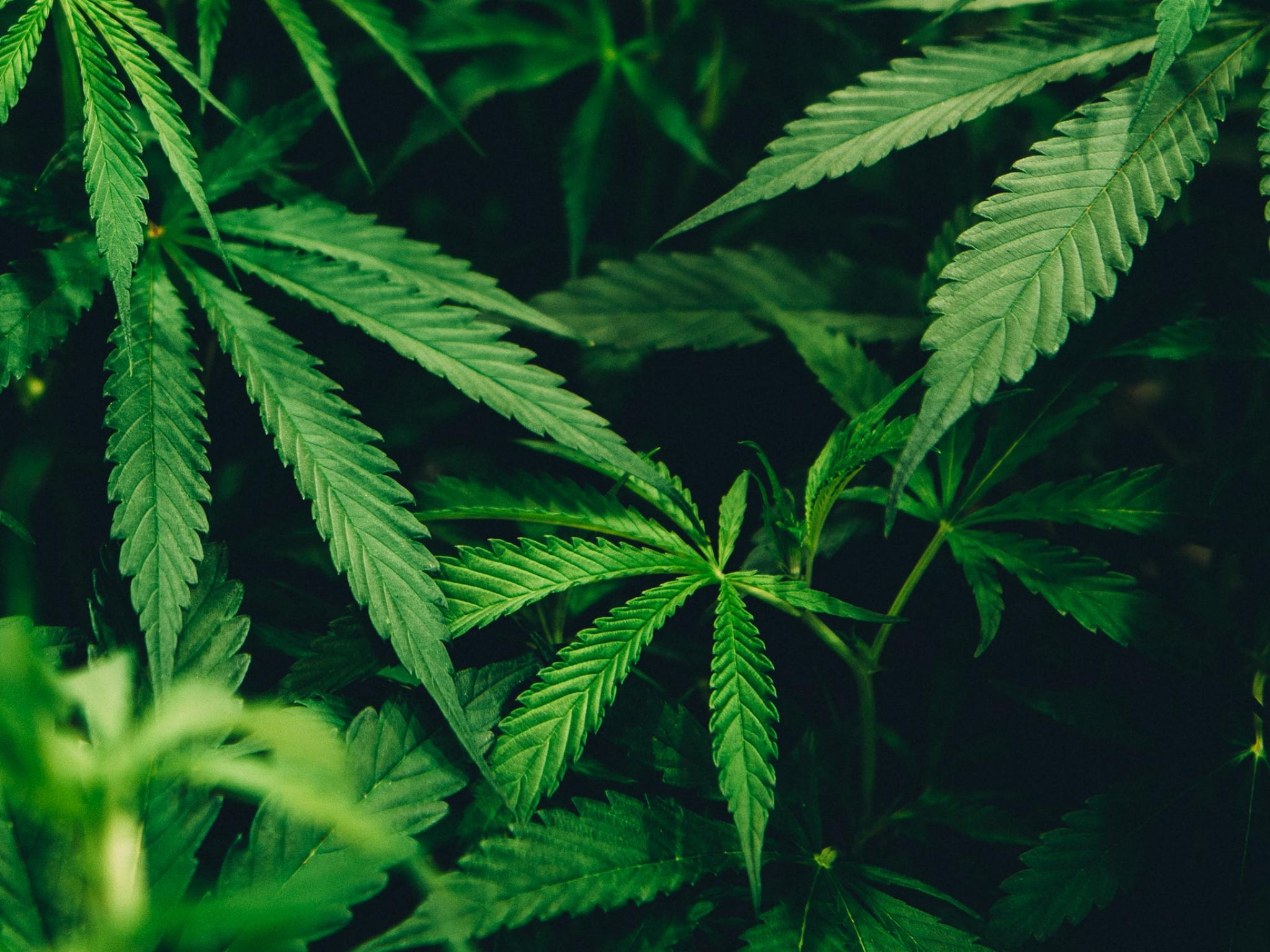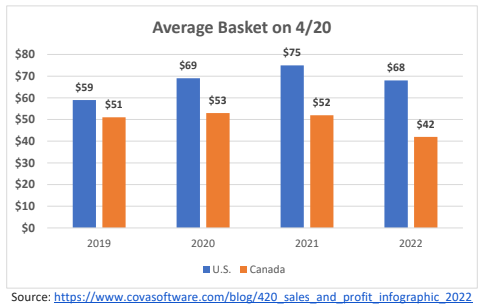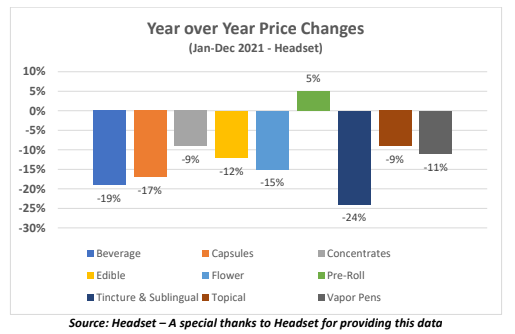
Summary:
● Inflation is having only a nominal impact on retail cannabis demand
● While states have experienced a decrease in demand, this decline is simply the returning to pre-pandemic consumption levels
● Cannabis demand has remained consistent and predictable during this period of increased inflation ● Data reflects this, both in dispensary visits, and per transaction spends
● This strong demand is not surprising, and is similar to the resiliency of cannabis demand in a recession ● Cannabis sales declines in the U.S. can be explained by two factors:
o A general return to the workplace
o Cannabis product price deflation
Price Inflation is at a Level Not Seen Since the 1980’s
Inflation can be understood as a general increase in the price of goods and services. Inflation has been a hot topic of conversation for most of this year, in the news, in meetings, and at conferences. Inflation rates, which are currently at 8.5%, have come up in discussions in the multiple national and state economic advisory groups that I support. Many of these conversations revolve around how the rise in inflation will impact overall demand in the marketplace, and how long the effects will be felt.
Inflation Means Reduced Purchasing Power, Fewer Jobs, Less Capital Investment
One result of inflation is that consumers have less purchasing power. If consumers are paying more for basic necessities like food, gas, or housing, then there is less money for them to save or to spend on other items like concert tickets, dinners out, and general goods and services. When consumers pull back on their spending, there is a rippling effect: the economy slows down, fewer jobs are needed, and there are fewer overall business investments being made.
Inflation’s Impact on Consumer Spending
The current post-Covid cycle is evolving differently from other business cycles. Transfer payments that were made by the federal government during the pandemic increased household wealth and maintained consumer spending power. While goods and services during the pandemic were in short supply, prices spiked, and even with these higher prices, consumers were still able and willing to pay. This cycle pushed prices even higher, resulting in the highest level of inflation since the 1980s. The data now show that consumers are starting to pull back on their spending as they are more focused on food, fuel, and housing. Other industries are now being impacted by this shift in consumer sentiment.
Inflation Has Nominal Impact on Cannabis Demand
Consumer demand for cannabis has been predictably resilient. One of the most common questions Whitney Economics has been receiving as of late has been whether or not inflation has had an impact on cannabis consumer demand. The answer to this question is no.
Cannabis Revenues are Declining - But Not Because of Inflation
Cannabis sales are declining, but this is not a result of inflation. The cannabis demand decline is actually a function of two general items:
• The return to work and school
• A general DEFLATIONARY environment for cannabis products
With fewer opportunities to consume cannabis throughout the day, and prices falling for most cannabis products, sales numbers are down in the U.S. This is not a surprise.
Back to Work Policies Lead to Decline in Cannabis Demand
During the pandemic, cannabis demand soared: consumers were able to consume while at home and working. In some states, such as Oregon, cannabis demand increased 35% year over year in both 2020 and 2021. In a September 2021 article, Whitney Economic correctly predicted a return to pre-pandemic growth rates as a result of cannabis consumers returning to work in the office. This indeed appears to be the case, as Colorado has suffered its first Year over Year decline in revenues. Data suggest that Oregon demand is faltering as well.
Source: Colorado Department of Revenue
Average Basket Sizes Returning to Pre-pandemic Levels.
During the pandemic, the average sales per transaction increased significantly. Cannabis consumers generally pooled money in their households and bought more per visit. This was not a phenomenon unique to cannabis. Starbucks and other retailers saw a similar pandemic purchasing pattern. Starbucks saw a significant increase in average transaction amounts both in 2020 and 2021. Now that there is less opportunity to consume cannabis (Back to the office), average basket levels are lower and slightly above pre-pandemic amounts. This shows that consumers are still spending on cannabis, despite higher inflation rates, but the consumer is not visiting the cannabis retailers as frequently and they are spending less when they do.
The below chart looks at the cannabis industry’s favorite day of the year: 4/20. Here, Whitney Economics has included data for that particular day for fun, but data on other dates show a similar pattern of cannabis purchases returning to pre-pandemic levels.

Product Price Deflation Also Contributes to Sales Decline

Cannabis Consumers Are Very Disciplined About Their Budgets
Cannabis consumers are very consistent on the money allocation toward cannabis products. A large percentage of cannabis demand comes from a smaller group of high-frequency users. Additionally, the demographics of the typical consumer show that these consumers have disposable incomes and can absorb price increases. As such, cannabis is fully ingrained into their lives and inflation will have little impact on these consumption patterns. While
some part-time consumers may reduce spending towards cannabis, the impact to the overall revenues is minimal. Therefore, cannabis demand is not significantly impacted by general U.S. inflation. This idea is consistent with the research Whitney Economics published on the impact of the pandemic on cannabis demand, ( https://whitneyeconomics.com/report/cannabis-in-the-new-economy-how-cannabis-investment-could-grow like-a-weed-in-the-coming-recession-may-2020 )
Cannabis Demand is Resilient: Inflation Will Not Impact Consumer Demand
In sum, the declines in cannabis retail revenues are a function of return-to-work policies, combined with price deflation in cannabis product offerings. The impact of general price inflation barely moves the needle on demand. However, that does not mean that overall inflation is not having an impact in the market.
In our next article, Whitney Economics will examine the impact that inflation is having on the sales ramps in states with recent and upcoming legal cannabis regulatory deployments. This is where inflation is having a real impact and may take a bite out of future growth in the cannabis industry.
Beau Whitney is the founder and Chief Economist at Whitney Economics, a global leader in cannabis and hemp business consulting, data, and economic research. Whitney Economics is based in Portland, Oregon.







